Fumin Shen
Truth in the Few: High-Value Data Selection for Efficient Multi-Modal Reasoning
Jun 05, 2025Abstract:While multi-modal large language models (MLLMs) have made significant progress in complex reasoning tasks via reinforcement learning, it is commonly believed that extensive training data is necessary for improving multi-modal reasoning ability, inevitably leading to data redundancy and substantial computational costs. However, can smaller high-value datasets match or outperform full corpora for multi-modal reasoning in MLLMs? In this work, we challenge this assumption through a key observation: meaningful multi-modal reasoning is triggered by only a sparse subset of training samples, termed cognitive samples, whereas the majority contribute marginally. Building on this insight, we propose a novel data selection paradigm termed Reasoning Activation Potential (RAP), which identifies cognitive samples by estimating each sample's potential to stimulate genuine multi-modal reasoning by two complementary estimators: 1) Causal Discrepancy Estimator (CDE) based on the potential outcome model principle, eliminates samples that overly rely on language priors by comparing outputs between multi-modal and text-only inputs; 2) Attention Confidence Estimator (ACE), which exploits token-level self-attention to discard samples dominated by irrelevant but over-emphasized tokens in intermediate reasoning stages. Moreover, we introduce a Difficulty-aware Replacement Module (DRM) to substitute trivial instances with cognitively challenging ones, thereby ensuring complexity for robust multi-modal reasoning. Experiments on six datasets show that our RAP method consistently achieves superior performance using only 9.3% of the training data, while reducing computational costs by over 43%. Our code is available at https://github.com/Leo-ssl/RAP.
Anti-Collapse Loss for Deep Metric Learning Based on Coding Rate Metric
Jul 03, 2024Abstract:Deep metric learning (DML) aims to learn a discriminative high-dimensional embedding space for downstream tasks like classification, clustering, and retrieval. Prior literature predominantly focuses on pair-based and proxy-based methods to maximize inter-class discrepancy and minimize intra-class diversity. However, these methods tend to suffer from the collapse of the embedding space due to their over-reliance on label information. This leads to sub-optimal feature representation and inferior model performance. To maintain the structure of embedding space and avoid feature collapse, we propose a novel loss function called Anti-Collapse Loss. Specifically, our proposed loss primarily draws inspiration from the principle of Maximal Coding Rate Reduction. It promotes the sparseness of feature clusters in the embedding space to prevent collapse by maximizing the average coding rate of sample features or class proxies. Moreover, we integrate our proposed loss with pair-based and proxy-based methods, resulting in notable performance improvement. Comprehensive experiments on benchmark datasets demonstrate that our proposed method outperforms existing state-of-the-art methods. Extensive ablation studies verify the effectiveness of our method in preventing embedding space collapse and promoting generalization performance.
Hierarchical Graph Pattern Understanding for Zero-Shot VOS
Dec 15, 2023



Abstract:The optical flow guidance strategy is ideal for obtaining motion information of objects in the video. It is widely utilized in video segmentation tasks. However, existing optical flow-based methods have a significant dependency on optical flow, which results in poor performance when the optical flow estimation fails for a particular scene. The temporal consistency provided by the optical flow could be effectively supplemented by modeling in a structural form. This paper proposes a new hierarchical graph neural network (GNN) architecture, dubbed hierarchical graph pattern understanding (HGPU), for zero-shot video object segmentation (ZS-VOS). Inspired by the strong ability of GNNs in capturing structural relations, HGPU innovatively leverages motion cues (\ie, optical flow) to enhance the high-order representations from the neighbors of target frames. Specifically, a hierarchical graph pattern encoder with message aggregation is introduced to acquire different levels of motion and appearance features in a sequential manner. Furthermore, a decoder is designed for hierarchically parsing and understanding the transformed multi-modal contexts to achieve more accurate and robust results. HGPU achieves state-of-the-art performance on four publicly available benchmarks (DAVIS-16, YouTube-Objects, Long-Videos and DAVIS-17). Code and pre-trained model can be found at \url{https://github.com/NUST-Machine-Intelligence-Laboratory/HGPU}.
* accepted by IEEE Transactions on Image Processing
BatchNorm-based Weakly Supervised Video Anomaly Detection
Nov 26, 2023Abstract:In weakly supervised video anomaly detection (WVAD), where only video-level labels indicating the presence or absence of abnormal events are available, the primary challenge arises from the inherent ambiguity in temporal annotations of abnormal occurrences. Inspired by the statistical insight that temporal features of abnormal events often exhibit outlier characteristics, we propose a novel method, BN-WVAD, which incorporates BatchNorm into WVAD. In the proposed BN-WVAD, we leverage the Divergence of Feature from Mean vector (DFM) of BatchNorm as a reliable abnormality criterion to discern potential abnormal snippets in abnormal videos. The proposed DFM criterion is also discriminative for anomaly recognition and more resilient to label noise, serving as the additional anomaly score to amend the prediction of the anomaly classifier that is susceptible to noisy labels. Moreover, a batch-level selection strategy is devised to filter more abnormal snippets in videos where more abnormal events occur. The proposed BN-WVAD model demonstrates state-of-the-art performance on UCF-Crime with an AUC of 87.24%, and XD-Violence, where AP reaches up to 84.93%. Our code implementation is accessible at https://github.com/cool-xuan/BN-WVAD.
MSFlow: Multi-Scale Flow-based Framework for Unsupervised Anomaly Detection
Aug 29, 2023Abstract:Unsupervised anomaly detection (UAD) attracts a lot of research interest and drives widespread applications, where only anomaly-free samples are available for training. Some UAD applications intend to further locate the anomalous regions without any anomaly information. Although the absence of anomalous samples and annotations deteriorates the UAD performance, an inconspicuous yet powerful statistics model, the normalizing flows, is appropriate for anomaly detection and localization in an unsupervised fashion. The flow-based probabilistic models, only trained on anomaly-free data, can efficiently distinguish unpredictable anomalies by assigning them much lower likelihoods than normal data. Nevertheless, the size variation of unpredictable anomalies introduces another inconvenience to the flow-based methods for high-precision anomaly detection and localization. To generalize the anomaly size variation, we propose a novel Multi-Scale Flow-based framework dubbed MSFlow composed of asymmetrical parallel flows followed by a fusion flow to exchange multi-scale perceptions. Moreover, different multi-scale aggregation strategies are adopted for image-wise anomaly detection and pixel-wise anomaly localization according to the discrepancy between them. The proposed MSFlow is evaluated on three anomaly detection datasets, significantly outperforming existing methods. Notably, on the challenging MVTec AD benchmark, our MSFlow achieves a new state-of-the-art with a detection AUORC score of up to 99.7%, localization AUCROC score of 98.8%, and PRO score of 97.1%. The reproducible code is available at https://github.com/cool-xuan/msflow.
AnoOnly: Semi-Supervised Anomaly Detection without Loss on Normal Data
May 30, 2023Abstract:Semi-supervised anomaly detection (SSAD) methods have demonstrated their effectiveness in enhancing unsupervised anomaly detection (UAD) by leveraging few-shot but instructive abnormal instances. However, the dominance of homogeneous normal data over anomalies biases the SSAD models against effectively perceiving anomalies. To address this issue and achieve balanced supervision between heavily imbalanced normal and abnormal data, we develop a novel framework called AnoOnly (Anomaly Only). Unlike existing SSAD methods that resort to strict loss supervision, AnoOnly suspends it and introduces a form of weak supervision for normal data. This weak supervision is instantiated through the utilization of batch normalization, which implicitly performs cluster learning on normal data. When integrated into existing SSAD methods, the proposed AnoOnly demonstrates remarkable performance enhancements across various models and datasets, achieving new state-of-the-art performance. Additionally, our AnoOnly is natively robust to label noise when suffering from data contamination. Our code is publicly available at https://github.com/cool-xuan/AnoOnly.
Co-attention Propagation Network for Zero-Shot Video Object Segmentation
Apr 08, 2023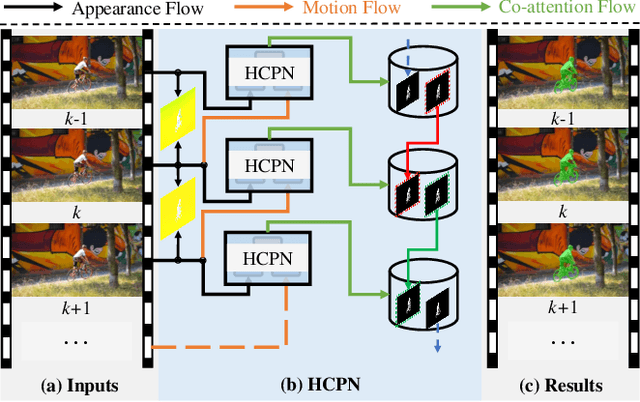

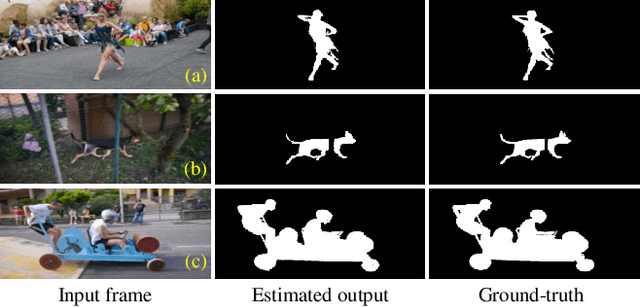
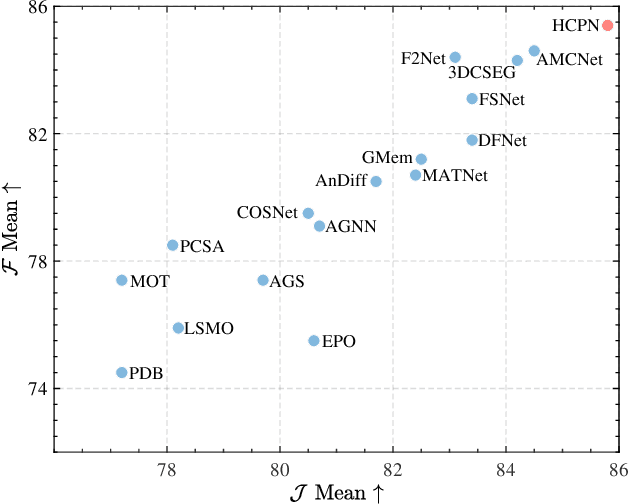
Abstract:Zero-shot video object segmentation (ZS-VOS) aims to segment foreground objects in a video sequence without prior knowledge of these objects. However, existing ZS-VOS methods often struggle to distinguish between foreground and background or to keep track of the foreground in complex scenarios. The common practice of introducing motion information, such as optical flow, can lead to overreliance on optical flow estimation. To address these challenges, we propose an encoder-decoder-based hierarchical co-attention propagation network (HCPN) capable of tracking and segmenting objects. Specifically, our model is built upon multiple collaborative evolutions of the parallel co-attention module (PCM) and the cross co-attention module (CCM). PCM captures common foreground regions among adjacent appearance and motion features, while CCM further exploits and fuses cross-modal motion features returned by PCM. Our method is progressively trained to achieve hierarchical spatio-temporal feature propagation across the entire video. Experimental results demonstrate that our HCPN outperforms all previous methods on public benchmarks, showcasing its effectiveness for ZS-VOS.
Attention Map Guided Transformer Pruning for Edge Device
Apr 04, 2023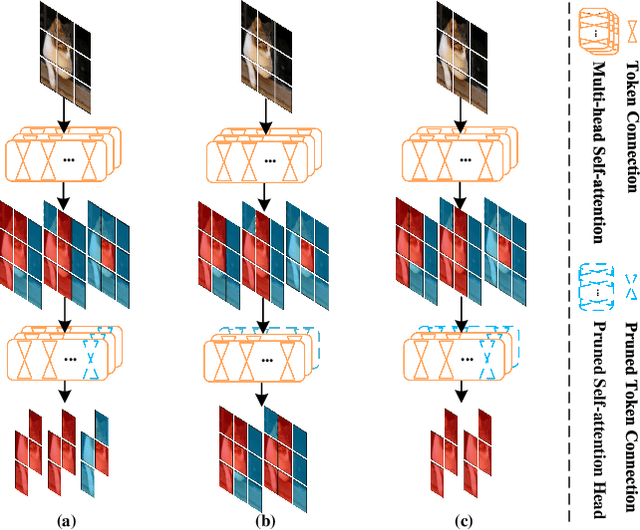
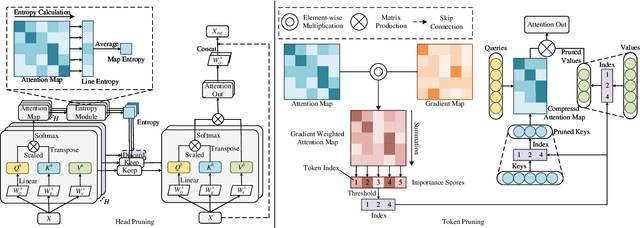
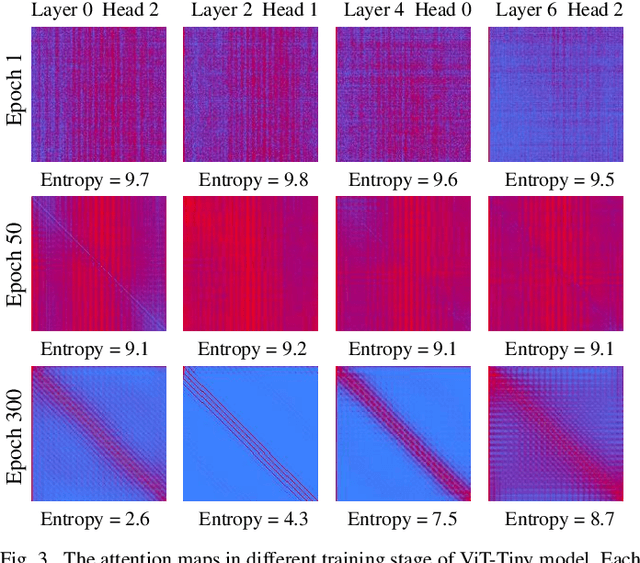

Abstract:Due to its significant capability of modeling long-range dependencies, vision transformer (ViT) has achieved promising success in both holistic and occluded person re-identification (Re-ID) tasks. However, the inherent problems of transformers such as the huge computational cost and memory footprint are still two unsolved issues that will block the deployment of ViT based person Re-ID models on resource-limited edge devices. Our goal is to reduce both the inference complexity and model size without sacrificing the comparable accuracy on person Re-ID, especially for tasks with occlusion. To this end, we propose a novel attention map guided (AMG) transformer pruning method, which removes both redundant tokens and heads with the guidance of the attention map in a hardware-friendly way. We first calculate the entropy in the key dimension and sum it up for the whole map, and the corresponding head parameters of maps with high entropy will be removed for model size reduction. Then we combine the similarity and first-order gradients of key tokens along the query dimension for token importance estimation and remove redundant key and value tokens to further reduce the inference complexity. Comprehensive experiments on Occluded DukeMTMC and Market-1501 demonstrate the effectiveness of our proposals. For example, our proposed pruning strategy on ViT-Base enjoys \textup{\textbf{29.4\%}} \textup{\textbf{FLOPs}} savings with \textup{\textbf{0.2\%}} drop on Rank-1 and \textup{\textbf{0.4\%}} improvement on mAP, respectively.
Hierarchical Feature Alignment Network for Unsupervised Video Object Segmentation
Jul 19, 2022



Abstract:Optical flow is an easily conceived and precious cue for advancing unsupervised video object segmentation (UVOS). Most of the previous methods directly extract and fuse the motion and appearance features for segmenting target objects in the UVOS setting. However, optical flow is intrinsically an instantaneous velocity of all pixels among consecutive frames, thus making the motion features not aligned well with the primary objects among the corresponding frames. To solve the above challenge, we propose a concise, practical, and efficient architecture for appearance and motion feature alignment, dubbed hierarchical feature alignment network (HFAN). Specifically, the key merits in HFAN are the sequential Feature AlignMent (FAM) module and the Feature AdaptaTion (FAT) module, which are leveraged for processing the appearance and motion features hierarchically. FAM is capable of aligning both appearance and motion features with the primary object semantic representations, respectively. Further, FAT is explicitly designed for the adaptive fusion of appearance and motion features to achieve a desirable trade-off between cross-modal features. Extensive experiments demonstrate the effectiveness of the proposed HFAN, which reaches a new state-of-the-art performance on DAVIS-16, achieving 88.7 $\mathcal{J}\&\mathcal{F}$ Mean, i.e., a relative improvement of 3.5% over the best published result.
Saliency Guided Inter- and Intra-Class Relation Constraints for Weakly Supervised Semantic Segmentation
Jun 20, 2022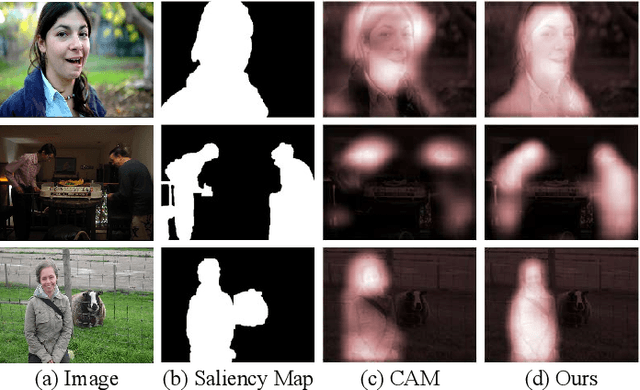
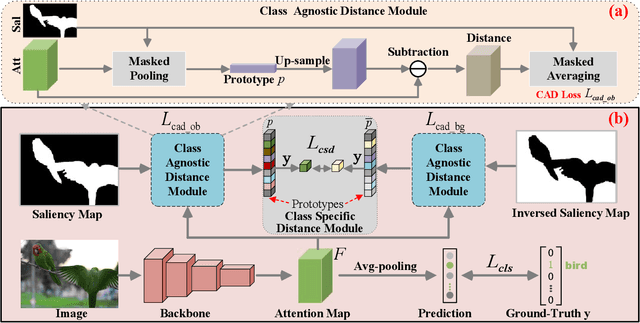
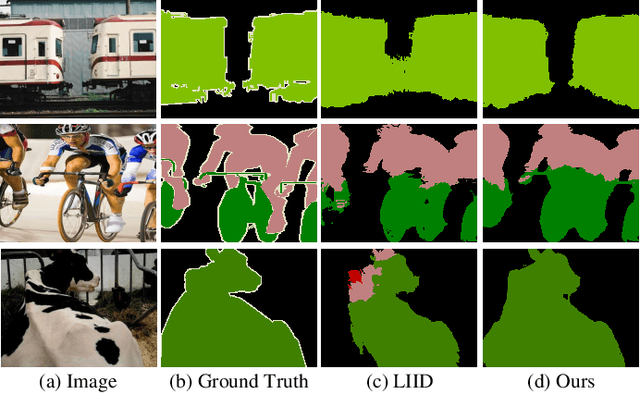
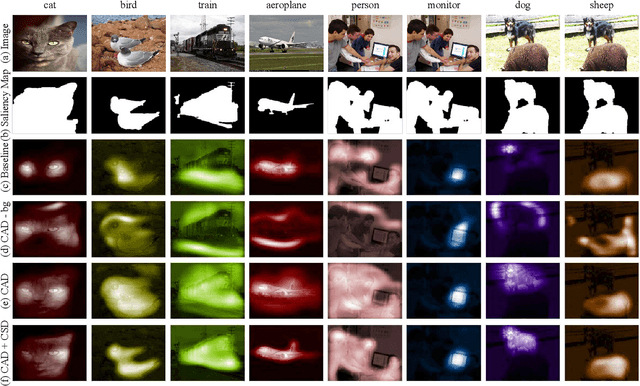
Abstract:Weakly supervised semantic segmentation with only image-level labels aims to reduce annotation costs for the segmentation task. Existing approaches generally leverage class activation maps (CAMs) to locate the object regions for pseudo label generation. However, CAMs can only discover the most discriminative parts of objects, thus leading to inferior pixel-level pseudo labels. To address this issue, we propose a saliency guided Inter- and Intra-Class Relation Constrained (I$^2$CRC) framework to assist the expansion of the activated object regions in CAMs. Specifically, we propose a saliency guided class-agnostic distance module to pull the intra-category features closer by aligning features to their class prototypes. Further, we propose a class-specific distance module to push the inter-class features apart and encourage the object region to have a higher activation than the background. Besides strengthening the capability of the classification network to activate more integral object regions in CAMs, we also introduce an object guided label refinement module to take a full use of both the segmentation prediction and the initial labels for obtaining superior pseudo-labels. Extensive experiments on PASCAL VOC 2012 and COCO datasets demonstrate well the effectiveness of I$^2$CRC over other state-of-the-art counterparts. The source codes, models, and data have been made available at \url{https://github.com/NUST-Machine-Intelligence-Laboratory/I2CRC}.
 Add to Chrome
Add to Chrome Add to Firefox
Add to Firefox Add to Edge
Add to Edge